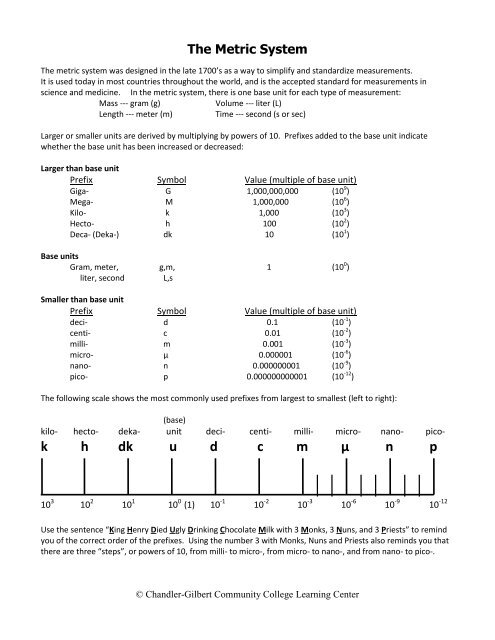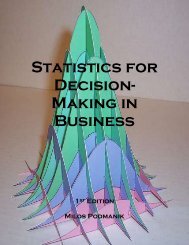Metric System - Chandler-Gilbert Community College
Metric System - Chandler-Gilbert Community College
Metric System - Chandler-Gilbert Community College
Create successful ePaper yourself
Turn your PDF publications into a flip-book with our unique Google optimized e-Paper software.
The <strong>Metric</strong> <strong>System</strong><br />
The metric system was designed in the late 1700’s as a way to simplify and standardize measurements.<br />
It is used today in most countries throughout the world, and is the accepted standard for measurements in<br />
science and medicine. In the metric system, there is one base unit for each type of measurement:<br />
Mass --- gram (g)<br />
Volume --- liter (L)<br />
Length --- meter (m)<br />
Time --- second (s or sec)<br />
Larger or smaller units are derived by multiplying by powers of 10. Prefixes added to the base unit indicate<br />
whether the base unit has been increased or decreased:<br />
Larger than base unit<br />
Prefix Symbol Value (multiple of base unit)<br />
Giga- G 1,000,000,000 (10 9 )<br />
Mega- M 1,000,000 (10 6 )<br />
Kilo- k 1,000 (10 3 )<br />
Hecto- h 100 (10 2 )<br />
Deca- (Deka-) dk 10 (10 1 )<br />
Base units<br />
Gram, meter, g,m, 1 (10 0 )<br />
liter, second L,s<br />
Smaller than base unit<br />
Prefix Symbol Value (multiple of base unit)<br />
deci- d 0.1 (10 -1 )<br />
centi- c 0.01 (10 -2 )<br />
milli- m 0.001 (10 -3 )<br />
micro- µ 0.000001 (10 -6 )<br />
nano- n 0.000000001 (10 -9 )<br />
pico- p 0.000000000001 (10 -12 )<br />
The following scale shows the most commonly used prefixes from largest to smallest (left to right):<br />
(base)<br />
kilo- hecto- deka- unit deci- centi- milli- micro- nano- picok<br />
h dk u d c m µ n p<br />
10 3 10 2 10 1 10 0 (1) 10 -1 10 -2 10 -3 10 -6 10 -9 10 -12<br />
Use the sentence “King Henry Died Ugly Drinking Chocolate Milk with 3 Monks, 3 Nuns, and 3 Priests” to remind<br />
you of the correct order of the prefixes. Using the number 3 with Monks, Nuns and Priests also reminds you that<br />
there are three “steps”, or powers of 10, from milli- to micro-, from micro- to nano-, and from nano- to pico-.<br />
© <strong>Chandler</strong>-<strong>Gilbert</strong> <strong>Community</strong> <strong>College</strong> Learning Center
Converting units within the metric system involves multiplying or dividing by powers of 10, which changes the<br />
placement of the decimal point. If you are moving from smaller units to larger ones (from right to left on the<br />
scale), the decimal point moves to the left. To convert form larger units to smaller ones, move the decimal to the<br />
right. To find out how many places the decimal needs to move, count the steps on the scale between the starting<br />
unit and the final unit.<br />
Example: Convert 0.016834 kilograms to centigrams.<br />
Looking at the scale on the previous page, you have to move 5 steps to the right to go from kilo- to centi-,<br />
so the decimal point moves 5 places to the right:<br />
0.016834 kg 1683.4 cg<br />
You can also change from one unit to another mathematically by using unit analysis with conversion factors. First<br />
identify the starting units given in the problem, then determine what units you need to change to. Find the<br />
relationship between the two units and use it to set up a conversion factor. Multiply the given value by the<br />
conversion factor to change from one unit to the other.<br />
Example: Convert 3470 meters to kilometers.<br />
Your starting unit is meters, and you need to change to kilometers.<br />
By referring to the list of prefixes, you find that 1,000 meters = 1 kilometer, so the two possible<br />
conversion factors are:<br />
1 kilometer or 1000 meters<br />
1,000 meters 1 kilometer<br />
In order to cancel out the starting unit (meters), you need the first conversion factor - the one that has<br />
the starting units in the denominator (on the bottom).<br />
Given measurement Conversion factor Final units<br />
3470 meters x 1 kilometer = 3470 kilometers = 3.470 kilometers<br />
1000 meters 1000<br />
More than one step may be required to complete a conversion. For example, when converting from one metric<br />
unit to another, it is usually easier to change from the starting units to base units, and then change to the final<br />
unit (i.e. kilograms grams centigrams). Problems involving metric-English conversions frequently require<br />
more than one step. Try to “plan your course” first by breaking down the conversion into smaller steps.<br />
Example: How many micrograms are in 7.3 kilograms<br />
Plan: convert kilograms grams, then grams micrograms<br />
Relationships: 1 kilogram = 10 3 grams; 1 microgram = 10 -6 grams<br />
7.3 kilograms x 10 3 grams x 1 microgram = (7.3 x 10 3 ) micrograms = 7.3 x 10 9 micrograms<br />
1 kilogram 10 -6 grams 10 -6<br />
Example: How many milliliters are in a 16.0-oz. carton of juice<br />
(Given: 1 quart = 32 oz, and 1 quart = 946 milliliters)<br />
Plan: convert ounces quarts, then quarts milliliters<br />
16.0 ounces x 1 quart x 946 mL = (16.0 x 946) mL = 473 milliliters<br />
32 oz 1 quart 32<br />
© <strong>Chandler</strong>-<strong>Gilbert</strong> <strong>Community</strong> <strong>College</strong> Learning Center

















